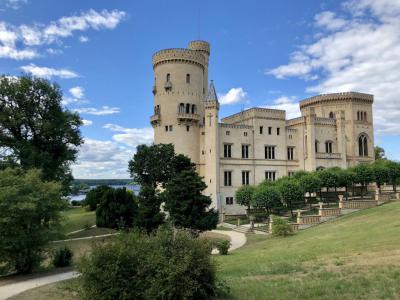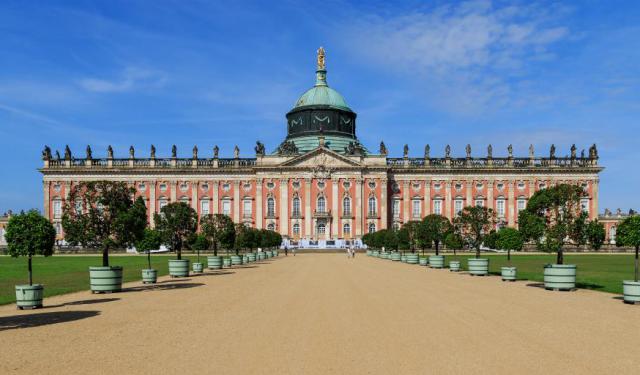Babelsberg Palace, Potsdam
Babelsberg Palace, known in German as Schloss Babelsberg, is a historic royal residence in Babelsberg Park in Potsdam, near Berlin. This palace served as the summer residence of Prince William, who later became German Emperor William I and King of Prussia, and his wife, Augusta of the House of Saxe-Weimar-Eisenach, the German Empress and Queen of Prussia, for over fifty years.
The palace, constructed in the English Gothic Revival style, was built in two phases between 1833 and 1849. The design and construction were initially overseen by the renowned architect Karl Friedrich Schinkel until he died in 1841. The project was then continued by Ludwig Persius and Johann Heinrich Strack. The architectural significance of Babelsberg Palace lies not only in its design but also in its influence, as it served as the model for constructing Kittendorf Palace in Mecklenburg-Vorpommern by Schinkel's pupil, Friedrich Hitzig.
One of the most historically significant events associated with Babelsberg Palace occurred on September 22, 1862, when a pivotal discussion occurred between King William I of Prussia and Otto von Bismarck. This meeting led to Bismarck's appointment as Minister President and Foreign Minister of Prussia, a role that would profoundly influence German and European history.
The palace is surrounded by terraces adorned with mosaics, sculptures, and beautifully arranged flowerbeds, leading to a Gothic fountain. These terraces transition into the English-style landscaped gardens designed by Peter Joseph Lenné and Hermann Fürst von Pückler-Muskau. The gardens feature winding paths that lead to the Flatowturm Tower, constructed between 1853 and 1856, which offers spectacular views of the surrounding area.
Babelsberg Palace was inscribed on the UNESCO World Heritage list in 1990. This recognition was given for its architectural cohesion and its importance as a testament to the power and influence of the Prussian monarchy.
The palace, constructed in the English Gothic Revival style, was built in two phases between 1833 and 1849. The design and construction were initially overseen by the renowned architect Karl Friedrich Schinkel until he died in 1841. The project was then continued by Ludwig Persius and Johann Heinrich Strack. The architectural significance of Babelsberg Palace lies not only in its design but also in its influence, as it served as the model for constructing Kittendorf Palace in Mecklenburg-Vorpommern by Schinkel's pupil, Friedrich Hitzig.
One of the most historically significant events associated with Babelsberg Palace occurred on September 22, 1862, when a pivotal discussion occurred between King William I of Prussia and Otto von Bismarck. This meeting led to Bismarck's appointment as Minister President and Foreign Minister of Prussia, a role that would profoundly influence German and European history.
The palace is surrounded by terraces adorned with mosaics, sculptures, and beautifully arranged flowerbeds, leading to a Gothic fountain. These terraces transition into the English-style landscaped gardens designed by Peter Joseph Lenné and Hermann Fürst von Pückler-Muskau. The gardens feature winding paths that lead to the Flatowturm Tower, constructed between 1853 and 1856, which offers spectacular views of the surrounding area.
Babelsberg Palace was inscribed on the UNESCO World Heritage list in 1990. This recognition was given for its architectural cohesion and its importance as a testament to the power and influence of the Prussian monarchy.
Want to visit this sight? Check out these Self-Guided Walking Tours in Potsdam. Alternatively, you can download the mobile app "GPSmyCity: Walks in 1K+ Cities" from Apple App Store or Google Play Store. The app turns your mobile device to a personal tour guide and it works offline, so no data plan is needed when traveling abroad.
Babelsberg Palace on Map
Sight Name: Babelsberg Palace
Sight Location: Potsdam, Germany (See walking tours in Potsdam)
Sight Type: Attraction/Landmark
Sight Location: Potsdam, Germany (See walking tours in Potsdam)
Sight Type: Attraction/Landmark
Walking Tours in Potsdam, Germany
Create Your Own Walk in Potsdam
Creating your own self-guided walk in Potsdam is easy and fun. Choose the city attractions that you want to see and a walk route map will be created just for you. You can even set your hotel as the start point of the walk.
Sanssouci Park Walking Tour
Sanssouci Park is a unique Potsdam landmark that occupies 290 hectares in the heart of the city. The Park is named after the Sanssouci Palace that it surrounds, which in turn takes its name from the French phrase "sans souci", which means carefree, and implies that the palace was designated as a place of fun, rather than a seat of power.
Indeed, the Sanssouci Palace was built in 1747... view more
Tour Duration: 2 Hour(s)
Travel Distance: 3.9 Km or 2.4 Miles
Indeed, the Sanssouci Palace was built in 1747... view more
Tour Duration: 2 Hour(s)
Travel Distance: 3.9 Km or 2.4 Miles
Potsdam Introduction Walking Tour
Potsdam was likely founded during the seventh century by the Hevelli tribe. The town was mentioned by the name of Poztupimi in a document from Emperor Otto III. The name likely came from an old Western Slavonic term roughly meaning "beneath the oaks."
By the early 1300s, a small town had formed with a town charter. By 1573 the town had around 2,000 people living there. Potsdam rose to... view more
Tour Duration: 2 Hour(s)
Travel Distance: 3.8 Km or 2.4 Miles
By the early 1300s, a small town had formed with a town charter. By 1573 the town had around 2,000 people living there. Potsdam rose to... view more
Tour Duration: 2 Hour(s)
Travel Distance: 3.8 Km or 2.4 Miles
Neuer Garten Walking Tour
Laid out at the behest of Friedrich William II in 1787, Potsdam's Neuer Garten (New Garden) was indeed "new" compared to the already in place Sanssouci Park.
Between 1816 and 1828, the area was modified further as an English-style, open landscape garden, with an aim to reproduce nature – trees and plants were left to grow naturally, unshaped and untrimmed. Rural life was also... view more
Tour Duration: 2 Hour(s)
Travel Distance: 2.8 Km or 1.7 Miles
Between 1816 and 1828, the area was modified further as an English-style, open landscape garden, with an aim to reproduce nature – trees and plants were left to grow naturally, unshaped and untrimmed. Rural life was also... view more
Tour Duration: 2 Hour(s)
Travel Distance: 2.8 Km or 1.7 Miles






